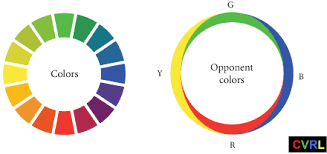Perception Exam 2 - Color Vision (Chapter 5)
1/19
There's no tags or description
Looks like no tags are added yet.
Name | Mastery | Learn | Test | Matching | Spaced |
|---|
No study sessions yet.
20 Terms
Which of the following lists the steps in color perception in the correct order?
Detection (sensing light) —> discrimination (differentiate between wavelengths) —> appearance (assignment of perceived colors to objects + assumption that colors are constant)
When looking at a blue sky during the day, ____ photoreceptors are most active, while looking at a red sky during sunset ____ photoreceptors are most active.
short cone, long cone
Color vision is best during what type of lighting condition?
Daylight condition (photopic)
The principle of univariance refers to the fact that:
When color processing is translated into one response (rods work alone and cannot process various combination of wavelengths)
An infinite set of different wavelength — intensity combination can elicit exactly the same response from a single type of photoreceptor
What type of color blindness results in a univariance problem?
Rod monochromat because univariance relies on rods
True color blindness
Both monochromat types are left with 1 signal, and thus a univariance problem
According to the Young-Helmholtz Theory, color vision can be understood best as:
Any light perception in human vision is dictated by combining 3 variables: S, M, L
RBG television and computer montiors have red, green, and blue pixels. Why don’t they have yellow pixels?
Metamers
Because they use the RGB color model, which combines red, green, and blue light to create a wide range of colors. By varying the intensity of these three primary colors the display can produce different hues. Yellow is created by mixing red and green light, so it is not necessary to have a separate yellow pixel.
Red + green is a metamer for yellow, so the red and green pixels can be lighted up together to cause the perception of yellow.
Mixing paints to create new colors is an example of ____ color mixing, while shining light to create new colors is an example of ____ color mixing.
subtractive, additive
In HSB (hue, saturation, brightness) color space, how does red differ from pink?
Same hue
Pink is brighter
Red is higher in saturation

Which of the following are pieces of evidence for color opponency?
Color canceling because two colors cancel each other out, they are opposites. Like blue and yellow, end up green, neither blue nor yellow
After images
ie. when you look at a red start and see green star on the wall

In the hue cancellation experiments described in the textbook, if the starting color were too reddish, you would add ___ to cancel that redness.
green
A single opponent cell in the LGN is shown to have a [color 1] + center and a [color 2-surround]. What would the wave length codes be for the center and for the surround?
Red: (L-M), Green: (M-L)
Yellow: (L(red)+M((green) - S(blue)
Blue: S(blue) - (L(red) + M(green))
in the red star, green star example — while staring at the red star, we stimulated the red-green complex; the red got stimulated, since it’s an opposing complex, green naturally got opposed/deactivated —> for 30 seconds we were stimulating red and deactivating green; shift from screen to wall, the red color was deactivated, green got activated (because of the opposing complex).
Imagine you travel to a foreign country that has labels that differentiate two very specific shades of orange. If someone from that country were given a color discrimination task involving shades of orange that either did or did not cross that label boundary, what would you predict their performance would look like?
Someone from this country would be able to discriminate between shades faster and more accurately than someone who is not from this country.
A(n) ___ is an individual who suffers from color blindness that is due to the absence of L-cones.
protanope (red color-blindness)
Color assimilation occurs when:
Two different colors are near each other and start to assimilate (or shift/”bleed”) into the other color, ending up in both colors taking up the chromatic quality of the other.
What piece of evidence suggests that color opponency processing occurs?
In the LGN and beyond, cone opponent cells can have a center-surround organization based on color (ie. red-green)
What is one potential explanation for why some people on the internet perceived “The Dress” as blue and black, while others perceived it as white and gold?
Individual differences in the perception of color constancy: our brain naturally ignore the “illuminant” or the light of the object’s surface. (ie. if there is a bluish light source, the blue stripe appears white; if there is a yellowish light source, the blue stripe appears blue)
Different mental references used
Which of the following shows evidence that color vision can impact other senses as well?
Synesthesia — when one stimulus evokes the experience of another that is not present which provides evidence the senses aren’t as divided as we think. Additionally, color serves a key aspect of attention and can alter that way we taste/smell (refer to wine-tasting experiment).
What wavelength of light would produce no response from an S cone, a moderate response from an M cone, and a large response from an L cone?
~625
This heuristic results in both color constancy effects and the perception of depth.
Shadow
Used the direction of the casted shadow to determine distance away
Determine that shadows in different gray originate from different colored luminance knowledge from shadow to make sense